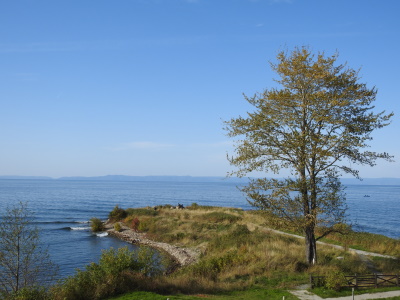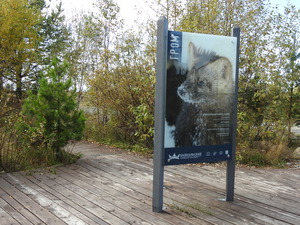Lake Baikal

Lake Baikal is a freshwater ecosystem comprising the deepest and oldest lake in the world, surrounded by highly valued protected areas.
The lake contains over one-fifth of the world's liquid fresh surface water. Notable fauna in the lake includes the endemic Baikal seal and fish species like the omul and the Baikal oil fish. The lake is completely surrounded by mountains, located in 5 national parks where the Siberian taiga meets the Mongolian steppes.
Community Perspective: This site is huge and there are many ways to get a good visit: Jarek used the Cirkum-Baikal railway, Jay did an excursion from the Transsiberian railway, Martina travelled on the frozen lake in the winter, as did Solivagant, and Els visited Bajkalski Biosphere Reserve (one of the surrounding parks).

Map of Lake Baikal
Community Reviews
Els Slots

There are dozens of ways to ‘do’ Lake Baikal. Previous reviewers already have highlighted the views from the Transsiberian Railway, its winter attractions and Olkhon Island. On my first day in the area, I did the touristy thing by taking a ‘Raketa’ ferry from Irkutsk via the Angara River to Listvyanka, walking on the boulevard along the lake, eating fried omul in the recommended Proshly Vek restaurant and visiting the Baikal museum. I actually had wanted to take the ferry all the way to Bolshie Koty (an isolated village only accessible on foot or via the lake), but that would have meant another 5 hours of entertaining myself without access to food or obvious attractions, something I did not look forward to after just finishing a 49-hour train ride with the same characteristics.
For the main part of my visit though, I focused on 1 of the 5 nature reserves that surround the lake and are part of the huge core zone as well. I had booked a tour to the Baikalsky Nature Reserve near Tankhoy, which meant a drive along the south side of the lake for some 250km. The lake is fully surrounded by mountains, so our first look at it was after crossing a mountain pass. From a vantage point near a restaurant, we did not only see the lake but also two railway tracks: one of them was the historic route around the lake and the other (the one higher up) the modern one. The next stop was Sable Mountain, a winter ski resort; here we took the chairlift up to get some more views. Ski tourism is promoted here to replace the local jobs that were lost after the closing of the notorious paper factory in 2013.
After leaving the Irkutsk region, we arrived in the Republic of Buryatia. Near the town of Tankhoy we found the main destination of this day: the Bajkalski Biosphere Reserve. It encompasses various separate locations (all signposted from the main road). We first took a hiking trail of a few kilometers through the woods and a swamp area. It has information panels every few hundred meters in English too. This forest consists mainly of Siberian pine. You also see many curved willows that have become crooked in winter due to the thick layers of snow. Siberian chipmunks live among the pines. The swamp area offers open views of the surrounding mountains, it is really beautiful here. There were only a few other hikers, some were picking berries - they are sold along the side of the road.
A few kilometers away lies another part of this nature reserve, a site with a large visitor center. In cages at the entrance 2 sable martens are kept: this local animal species in the past was much in demand because of its good quality fur. They are mainly nocturnal animals and even in captivity, they were difficult to find late in the afternoon. We finally found one of the two under a tree trunk – but I only saw its fur and one ear (here's a recent, better photo taken at the same spot). When at the visitor center, don’t miss the reconstructed old station building next to it. A very nice scale model has been made of how train traffic around Lake Baikal proceeded around 1900. The train went on a ferry at Port Baikal, was transferred across the lake and then came ashore here at Tankhoy.
Finally, we went to the Baikal bird ringing station. We first had to pick up one of their volunteers and then drive 30 kilometers further east towards Ulan Ude. Via a dirt road full of holes and mud we reached the edge of Lake Baikal again. There is a historic bird ringing station there, where statistics about birds around Lake Baikal have been kept for decades. Volunteers are permanently at work to check the nets every hour for birds that have been caught. It is apparently a good spot as the Lake is too wide for small birds to cross, so they fly along its edges. We arrived a little after 5 o'clock and the yield of this hour was only moderate: one red-flanked blue tail. It was a small and somewhat stupid bird - 2 hours before it had also ended up in the nets and was counted (he already had a ring from being caught before). So we could not experience the real 'ringing' of the birds due to a lack of birds, but the volunteer explained well how everything works. We walked past some of the nets around the station to look for 'fresh' birds, but there were none.
Overall, my visit to Lake Baikal was a very satisfying one and the highlight of my Russia trip. There are so many interesting things to discover about this lake, its natural environment and its human history, that it continues to fascinate. You can certainly enjoy yourself there for a week and I wouldn't mind going back for a multi-day tour or long hike.
Read more from Els Slots here.
Jay T

I was told when visiting Lake Baikal that to dip your hand or foot into the lake would add five years to your life, to step in with both feet would add ten years, and to fully swim would add 25 years. I may have been young and callow, but I wasn't rash enough to actually swim in those frigid waters; I limited myself to walking in up to my knees, and even then I thought I might actually have lost years from my life rather than adding them on! Lake Baikal has a great history, from a legend explaining how the lake and the Angara River flowing from it were formed, to more modern tales of the struggles to complete a rail line around the lake. I visited Lake Baikal during a cross-country trip on the Trans-Siberian railroad, and enjoyed both a picnic lunch with Russian shashlik (shish-kebabs) on the southwestern shore of the lake and a boat ride on the lake. The early May weather was warm, and the clear water looked deceptively refreshing; the lake's depth kept it cold, however. In fact, as we noted the next day on the train journey, ice was still present on Baikal's surface further north. The lake was as beautiful as I had imagined, and I highly recommend a visit for anyone who finds themselves traveling across Russia. I also recommend a visit to the town of Listvyanka, which offers a museum explaining the natural history of the lake as well as an outdoor museum displaying traditional wooden architecture.
Logistics: Tours or transportation to Lake Baikal can be arranged in Irkutsk; a trip on the Trans-Siberian railroad will circumnavigate the southern and eastern shores of the lake.
Martina Rúčková

Lake Baikal is one of those WHSs you can dedicate more time to and you will not regret it. And while we're at it, let me recommend you to plan your visit for winter, when the lake is under the ice. Not only is your scope of activities wider and modes of transportation more flavourful, but the whole experience would be that much more enjoyable. There is nothing like the majestic lake crusted with a thick layer of ice clear as glass.
Ivan and I went in March 2016 and took two guests with us: Ivan's brother-in-law and his classmate from the university, then created a custom trip for eight days around lake Baikal with a local tour operator Baikalika. They arranged accomodation and transport for us and a guide for a short three-hour-long sightseeing trip around Irkutsk. From there we drove to the Olkhon Island, spent two nights there, having many fun activities on the frozen lake (picnic on the ice, skating, exploring the ice caves, etc.) and enjoying our evenings in banya in our accomodation complex in Khuzhir. Incidentally, Khuzhir is a great place to explore in its own right. People still live there but it has this curious feeling of being forsaken and in abandon, helped by the rusting ships half sinking, frozen, with ice shards all around them. Shrines around Olkhon represent the two aspects of the local spiritual culture: the Buddhist and the Shamanist, each of them fascinating.
From Olkhon we moved on to Buguldeyka with some small walks along the coastline, then changed into a hovercraft that took us to Listvyanka - main tourist town on the shores of lake Baykal. Mayak Hotel is your recommended place to stay, it's the best you can get, their restaurant is very good, at least some semblance of English is spoken and their banya is fantastic. They provide everything, there is a generously sized pool with cold water and you can order very nice meals and vodka to the table just beside the pool. And it's privately rented, so all yours for three or four hours. As for activities in Listvyanka, there is mushing, nerpinarium, museum, you can take a ride on snow scooters and even have a picnic on a shard of ice they cut off and send down the stream of river Angara (and then pray they won't forget about you and come for you).
Another hovercraft took us across the lake to the Baikal State Natural Reserve, already part of the Buryatia Republic, where we took a hike into the actual reserve and then enjoyed lunch made by local Buryats. We also visited village of Tarabagatay where the People of Old Ways live (Starobryadtsi) whose polyphonic way of siging is an intangible World Heritage. There's also a village of Ivolginsk with their Buddhist datsan. After that, there's only a massive bust of Lenin in Ulan-Ude and you can fly back wherever you need to be via Moscow.
In summer the lake is swarmed by Russian tourists who camp there and our friends who went complained about the noise, the smell, the garbage and the mosquitoes. The only annoying thing in winter are many groups of tourists (mostly Asian and Russian, with some lost folks from Europe here and there) and the cold. Clothes that will keep you warm at the temperatures of around -20 C are a must and copious amounts of vodka constitute a good coping mechanism. Should you wish to make it a tour, the travel agency I mentioned above is good, they speak English and have good track record with foreign tourists. Anyone insane enough to spend couple of days on Russian train can take the Trans-Siberian railway all the way to Irkutsk, see the lake and then continue to Mongolia and Beijing. If you want to do it on your own, some accomodation options in Listvyanka are available online and you can arrange both taxi and marshrutka between Listvyanka and Irkutsk easily. Would I reccommend seeing this WHS? In a heartbeat!
Jarek Pokrzywnicki
I was visiting Baikal Lake in late spring (June) 2008, having seen Listwianka, Sludianka towns, Olkhon Island and travelling via so called Cirkum-Baikal railway. The most remarkable sceneries are of course those of Olkhon (the majestic Sayan mountains over the so called "Small Sea" seen from Khuzyr village is something that will be remembered for life). Nerpa seals are on display (alive) in Baikal Museum in Listwianka, the best place to start a trip is undoubtfully Listwianka (available private flats to rent as well as numerous hotels and hostels) and during season there are jet-lake transportation as far as the most northern part of Baikal (Severobaikalsk).
Solivagant

We chose to visit Siberia in winter (as long ago as March 1989 - no doubt it will be a different world now) in order to experience it as it “ought to be” – covered in ice and snow! It was a somewhat rushed trip by Trans Siberian railway with minimal stop-overs. The train journey in from Ulan Ude takes you along the South Eastern shore with nice mountain scenery but our visit to the lake itself took us to the village of Listvyanka on a day trip from Irkutsk. The village receives more tourists than anywhere else around the Lake and has a Limnological Institute where you can learn something of the ecology of the lake. It is situated near the exit point of the Angara river from the Lake as it starts its long journey north through Irkutsk, Bratsk and eventually to the Yenisei and the Arctic Ocean.
For us the most amazing part of the trip was to walk out on the ice covering the lake. Not just that but to have heavy lorries passing by! (photo). In winter the lake serves as a road on ice which is (we were told) 1 metre thick. We were led to question whether this was really enough as the ice-sheet swayed up and down in response to the passage of the lorries! No doubt those who live in Scandinavia or continental N Europe/N America are used to walking on lakes but it was a novel experience for us. The thought that this was the deepest fresh water lake in the world with up to 1.6 kms of water beneath us made it a memorable visit.
The unique ecology which has led to the Lake being inscribed on the WHS list is not really accessible to the passing tourist and to that extent a visit is always going to be a slight disappointment. The famous Baikal seals are apparently visible at the Ushakanyi islands but to get to them requires a boat trip and a stay of several days in the area. I have seen the scenery praised as eg “There is probably no more beautiful place in Russia…”. This is to overdo it in my opinion.
The place is, however, undoubtedly “interesting” and I would certainly recommend a winter visit..
Community Rating
- : Ivan Rucek Martina Rúčková Alexander Barabanov Alexander Lehmann George Gdanski Kasper AYB Theyeattheworld Panacci Alexandrcfif
- : Jay T Hanming
- : Els Slots Solivagant Wojciech Fedoruk Vicente B. Avanzado Jr. Michael anak Kenyalang D.dedisse@vogo.fr Finsbury_jo Mihai Dascalu StaziG Marie
- : Eateateat Mahuhe
- : Ammon Watkins
- : Joyce van Soest Xtopher33 ZCTLife
- : Yevhen Ivanovych
- : Geert Luiken
Site Info
- Full Name
- Lake Baikal
- Unesco ID
- 754
- Country
- Russia
- Inscribed
- 1996
- Type
- Natural
- Criteria
-
7 8 9 10
- Categories
- Natural landscape - Rivers, Wetlands and Lakes
- Link
- By ID
Site History
1996 Inscribed
Site Links
Unesco Website
Official Website
Related
In the News
Connections
The site has 37 connections
Damaged
Ecology
Geography
History
Human Activity
Individual People
Religion and Belief
Science and Technology
Timeline
Trivia
WHS Names
WHS on Other Lists
World Heritage Process
Visitors
125 Community Members have visited.
The Plaque
 (photo by Els)
(photo by Els)